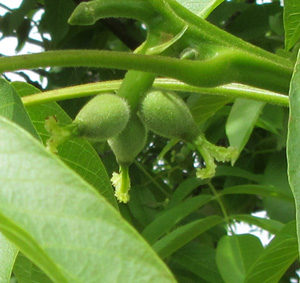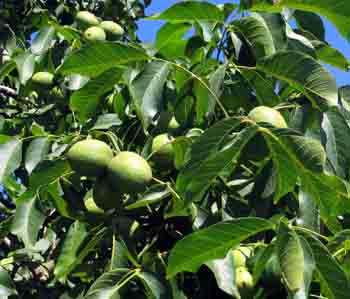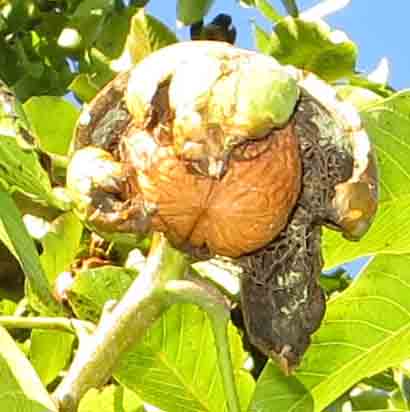(Located E1, M1, Planted 2005 Also W1 A10, A17 and A22)
(Juglans regia) English Walnuts have separate male and female flowers on one tree. The pollen can be shed when the female flowers are not receptive so pollination may be better with two varieties.
Thin crowded areas to let light into the tree in late winter. Blossoms and new shoots do not tolerate frost, so late leafing varieties are preferred for coastal areas. They prefer slightly acid soil with some nitrogen fertilizer each spring after the 1st year. Mature trees may be fertilized with 90-100 lb of aged manure. Keep the area at the base of the tree free of weeds and grass to lower competition for nutrients and moisture and reduce pest problems.
Nuts are mature when the green hulls begin to break away from the shell. Do not leave on the tree but gently shake them out of the tree with long wood poles or PVC pipe (which you can get at the hardware store). Hulls which do not drop with gentle shaking are probably not ready yet. Remove the hulls and wash (with plastic gloves to avoid staining).
A diluted chlorine solution may be used to discourage mold. They should be dried rapidly in a warm room on screens for good air circulation (keeping an eye out for mold) or in a dehydrator at about 115 degrees F. The fresh, raw nuts that have only been partially dried are a tasty treat but they must be completely dried for storage or they will quickly mold. If hulls begin to mold wash in a solution of diluted chlorine and dry as above. Do not eat if the nut inside is moldy.
Freeze to kill any worms if they will be stored for any length of time. After removing from the freezer they may be stored in plastic containers as long as they are dry.
We have four large walnut trees along the south and west fences of the fruit garden. When taking our snack break each sunny work day, we sit in the shade of a walnut tree.
A few years ago, lightning struck the walnut tree on the south part of the west fence. You can see the dark long vertical line in the bark on the main trunk. The tree seems to not be damaged. No one was in the garden at the time.






